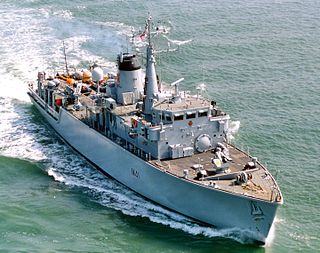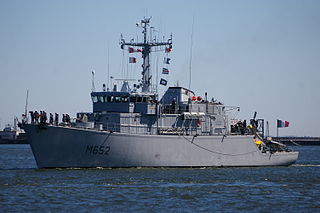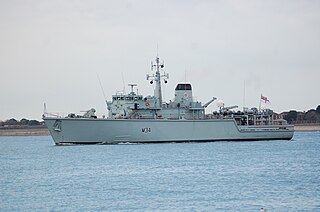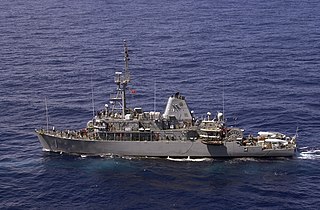
A minehunter is a naval vessel that seeks, detects, and destroys individual naval mines. Minesweepers, on the other hand, clear mined areas as a whole, without prior detection of mines. A vessel that combines both of these roles is known as a mine countermeasures vessel (MCMV).

The Hunt class is a class of thirteen mine countermeasure vessels of the Royal Navy. As built, they combined the separate roles of the traditional minesweeper and that of the active minehunter in one hull, but later modifications saw the removal of mine-sweeping equipment. They have a secondary role as offshore patrol vessels.

The Ton class were coastal minesweepers built in the 1950s for the Royal Navy, but also used by other navies such as the South African Navy and the Royal Australian Navy. They were intended to meet the threat of seabed mines laid in shallow coastal waters, rivers, ports and harbours, a task for which the existing ocean-going minesweepers of the Algerine-class were not suited.
HMS Kirkliston (M1157) was a Ton-class minesweeper of the Royal Navy, built by Harland and Wolff and launched on 18 February 1954. In a brief episode from 1956 to 1960 she was temporarily renamed HMS Kilmorey and was assigned to the Ulster division Royal Naval Reserve (RNR).

HMS Bangor is a Sandown-class minehunter commissioned by the Royal Navy in 1999. Designed to hunt naval mines in depths of up to 200 m (660 ft) using the Sonar 2093 Variable Depth Sonar (VDS) meaning that she can conduct mine clearance operations throughout the continental shelf. She is named after the Northern Ireland seaside city of the same name, and the second Royal Navy vessel to bear the name. As of January 2024, she was the last vessel of her class in active Royal Navy service.

The Tripartite class is a class of minehunters developed from an agreement between the navies of Belgium, France and the Netherlands. A total of 35 ships were constructed for the three navies. The class was constructed in the 1980s–1990s in all three countries, using a mix of minehunting, electrical and propulsion systems from the three member nations. In France, where they are known as the Éridan class they are primarily used as minehunters, but have been used for minesweeping and ammunition transport in Belgium and the Netherlands, where the Tripartites are known as the Alkmaar class.

HMS Ledbury, the second ship of the name, is a Hunt-class mine countermeasures vessel of the Royal Navy. She was launched in December 1979 and commissioned on 11 June 1981, the second ship of her class. She cost £65 million at time of building, which was at the time the most expensive cost-per-metre for any class of ship built by the Royal Navy. Most of this cost went into the research and development of Ledbury's glass reinforced plastic hull.

HMS Brocklesby is a Hunt-class mine countermeasures vessel of the British Royal Navy, her primary purpose is to find and neutralise sea mines using a combination of; Sonar, Mine Clearance Divers and the Seafox remotely operated vehicle (ROV). The class are the largest warships of glass-reinforced plastic (GRP) construction, which gives the vessels a low magnetic signature. In addition to her mine countermeasures activities, Brocklesby acts as an offshore patrol vessel, undertaking coastal patrol and fisheries protection duties.

HMS Middleton is a Hunt-class mine countermeasures vessel of the British Royal Navy. As of 2021, she forms part of 9th Mine Countermeasures Squadron operating out of HMS Jufair in Bahrain.

The Commandant Rivière class was a class of frigates built for the French Navy in the late 1950s and early 1960s. Labeled "aviso-escorteur", they were designed to perform the role of overseas patrol in peacetime and anti-submarine escort in wartime. This vessel class is named after the French Navy officer Henri Rivière (1827–1883).

The Kuha-class minesweepers is a series of six inshore minesweepers of the Finnish Navy. The ships were constructed in 1974–1975. All the vessels of the class were modified and modernized in the late 1990s, including a lengthening of the hull. Two of the class were withdrawn from service in 2012. The rest of the class will be retired with the entry into service of the Katanpää-class mine countermeasure vessels.

Avenger-class mine countermeasures ships are a class of 14 ships constructed for the United States Navy from 1987 to 1994, designed to clear mines from vital waterways. The ships have the hull designator MCM.
HMS Iveston was a Ton-class minesweeper of the Royal Navy launched on 1 June 1954 by Philip and Son in Dartmouth. After her decommissioning in 1992, HMS Iveston became the Sea Cadet training ship T.S. Iveston. She was sold and scrapped in March 2015.

The Sparviero class, also known as the Nibbio class, are small hydrofoil missile boats capable of traveling at speeds of 46 knots. They were designed for and formerly used by the Italian Navy. The Japanese 1-go-class missile boat is an updated version formerly used by the Japan Maritime Self-Defense Force (JMSDF).
HMS Shoulton (M1182) was a Ton-class minesweeper of the Royal Navy. Constructed by the Montrose Shipyard in Montrose, Scotland and launched on 10 September 1954, the minesweeper was converted into a prototype minhunter in 1957. The vessel was used as a test bed in the mid-1960s for new propulsion technologies. Shoulton was among the vessels assigned to salvage operations following the Aer Lingus Flight 712 crash off Rosslare. In 1977, Shoulton took part in the naval review marking the Silver Jubilee of Elizabeth II and was paid off on 23 November 1979. The ship was sold for scrap in 1981 and broken up at broken up in Blyth.
HMS Hodgeston was a Ton-class minesweeper which saw service with the Royal Navy during the Cold War. Built by Fleetlands Shipyard, she was launched on 6 April 1954 and broken up in 1988.
HMS Brereton (M1113) was a Ton-class minesweeper of the Royal Navy. Brereton was built by the Lowestoft shipbuilder Richard Ironworks, and was launched in 1953 and entered service in 1954.

The Fleet-class unmanned surface vessel, also called the Common Unmanned Surface Vessel (CUSV) and later the Mine Countermeasures Unmanned Surface Vehicle, is an unmanned surface vessel designed for the United States Navy to be deployed from Freedom and Independence-class littoral combat ships and intended to conduct mine and anti-submarine warfare missions. As of 2012 four units of the class have been built; the first was delivered to the U.S. Navy in 2008.












